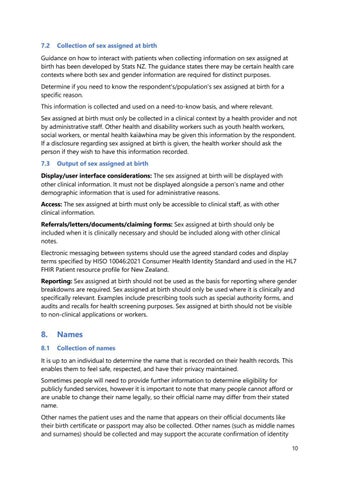7.2
Collection of sex assigned at birth
Guidance on how to interact with patients when collecting information on sex assigned at birth has been developed by Stats NZ. The guidance states there may be certain health care contexts where both sex and gender information are required for distinct purposes. Determine if you need to know the respondent's/population's sex assigned at birth for a specific reason. This information is collected and used on a need-to-know basis, and where relevant. Sex assigned at birth must only be collected in a clinical context by a health provider and not by administrative staff. Other health and disability workers such as youth health workers, social workers, or mental health kaiāwhina may be given this information by the respondent. If a disclosure regarding sex assigned at birth is given, the health worker should ask the person if they wish to have this information recorded. 7.3
Output of sex assigned at birth
Display/user interface considerations: The sex assigned at birth will be displayed with other clinical information. It must not be displayed alongside a person’s name and other demographic information that is used for administrative reasons. Access: The sex assigned at birth must only be accessible to clinical staff, as with other clinical information. Referrals/letters/documents/claiming forms: Sex assigned at birth should only be included when it is clinically necessary and should be included along with other clinical notes. Electronic messaging between systems should use the agreed standard codes and display terms specified by HISO 10046:2021 Consumer Health Identity Standard and used in the HL7 FHIR Patient resource profile for New Zealand. Reporting: Sex assigned at birth should not be used as the basis for reporting where gender breakdowns are required. Sex assigned at birth should only be used where it is clinically and specifically relevant. Examples include prescribing tools such as special authority forms, and audits and recalls for health screening purposes. Sex assigned at birth should not be visible to non-clinical applications or workers.
8.
Names
8.1
Collection of names
It is up to an individual to determine the name that is recorded on their health records. This enables them to feel safe, respected, and have their privacy maintained. Sometimes people will need to provide further information to determine eligibility for publicly funded services, however it is important to note that many people cannot afford or are unable to change their name legally, so their official name may differ from their stated name. Other names the patient uses and the name that appears on their official documents like their birth certificate or passport may also be collected. Other names (such as middle names and surnames) should be collected and may support the accurate confirmation of identity 10

